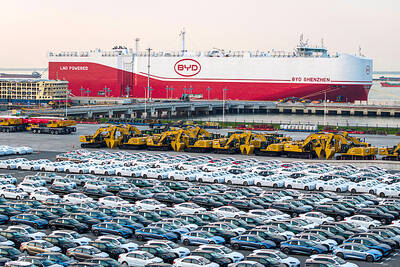DRAM chipmaker Nanya Technology Corp (南亞科技) yesterday said that its net profit surged 77 percent last quarter, as rising prices lifted its gross margin to a seven-quarter high.
Net profit rose to NT$3.28 billion (US$108.8 million) during the quarter ending March 31, compared with NT$1.85 billion a year ago. Earnings per share rose to NT$1.19 from NT$0.68 during the same period.
Gross margin climbed to 40.1 percent last quarter, compared with 32.7 percent in the previous year, thanks to a 25 percent price hike on an annual basis, the company’s financial statement showed.
“We would have reported even better profits if not for the impact of a volatile currency exchange rate,” Nanya Technology president Lee Pei-ing (李培瑛) told reporters.
The Taoyuan-based memorychip maker booked a foreign-exchange loss of NT$575 million in the first quarter, reversing a foreign-exchange gain of NT$480 million in the final quarter of last year.
Lee gave an upbeat outlook for the current quarter amid expectations that DRAM chip prices would continue rising for at least two quarters.
DRAM chip prices are forecast to increase by 10 percent this quarter, bolstered by growing demand for consumer electronics, such as ultra-high-definition 4K TVs and set-top boxes, as well as corporate PCs and servers.
A healthy supply and demand balance also underlies his optimism.
“Supply is still about 1 percent short of demand,” Lee said. “Most supply increases are coming from technology upgrade, which means very limited growth.”
As prices continue to climb, Lee expects “the second quarter will be a better period than the first [quarter] in terms of profitability.”
Nanya Technology also expects shipments to be back on track this quarter after it has fully adjusted equipment for the migration to 20-nanometer (nm) process technology from 30nm.
The chipmaker expects to begin shipping a small volume of 20nm chips next quarter.
As demand in the second half is usually stronger than the first half, Lee said he is optimistic about the third quarter.
For one, smartphone makers will need higher density memorychips for their new mid-to-high-end models that come with dual-lens cameras, he said.
Risks to growth could emerge in the fourth quarter, assuming the world’s major memory chipmakers, such as Samsung Electronics and SK Hynix, decide to reallocate capacities to DRAM chips once supply of 3D NAND flash memorychips outpaces demand, Lee said.
Nanya Technology has set a higher capital expenditure of NT$34.3 billion for this year, compared with NT$22.3 billion last year, most of which is to be used for its technology migration.

Micron Memory Taiwan Co (台灣美光), a subsidiary of US memorychip maker Micron Technology Inc, has been granted a NT$4.7 billion (US$149.5 million) subsidy under the Ministry of Economic Affairs A+ Corporate Innovation and R&D Enhancement program, the ministry said yesterday. The US memorychip maker’s program aims to back the development of high-performance and high-bandwidth memory chips with a total budget of NT$11.75 billion, the ministry said. Aside from the government funding, Micron is to inject the remaining investment of NT$7.06 billion as the company applied to participate the government’s Global Innovation Partnership Program to deepen technology cooperation, a ministry official told the

Taiwan Semiconductor Manufacturing Co (TSMC, 台積電), the world’s leading advanced chipmaker, officially began volume production of its 2-nanometer chips in the fourth quarter of this year, according to a recent update on the company’s Web site. The low-key announcement confirms that TSMC, the go-to chipmaker for artificial intelligence (AI) hardware providers Nvidia Corp and iPhone maker Apple Inc, met its original roadmap for the next-generation technology. Production is currently centered at Fab 22 in Kaohsiung, utilizing the company’s first-generation nanosheet transistor technology. The new architecture achieves “full-node strides in performance and power consumption,” TSMC said. The company described the 2nm process as

POTENTIAL demand: Tesla’s chance of reclaiming its leadership in EVs seems uncertain, but breakthrough in full self-driving could help boost sales, an analyst said Chinese auto giant BYD Co (比亞迪) is poised to surpass Tesla Inc as the world’s biggest electric vehicle (EV) company in annual sales. The two groups are expected to soon publish their final figures for this year, and based on sales data so far this year, there is almost no chance the US company led by CEO Elon Musk would retain its leadership position. As of the end of last month, BYD, which also produces hybrid vehicles, had sold 2.07 million EVs. Tesla, for its part, had sold 1.22 million by the end of September. Tesla’s September figures included a one-time boost in

Shares in Taiwan closed at a new high yesterday, the first trading day of the new year, as contract chipmaker Taiwan Semiconductor Manufacturing Co (TSMC, 台積電) continued to break records amid an artificial intelligence (AI) boom, dealers said. The TAIEX closed up 386.21 points, or 1.33 percent, at 29,349.81, with turnover totaling NT$648.844 billion (US$20.65 billion). “Judging from a stronger Taiwan dollar against the US dollar, I think foreign institutional investors returned from the holidays and brought funds into the local market,” Concord Securities Co (康和證券) analyst Kerry Huang (黃志祺) said. “Foreign investors just rebuilt their positions with TSMC as their top target,